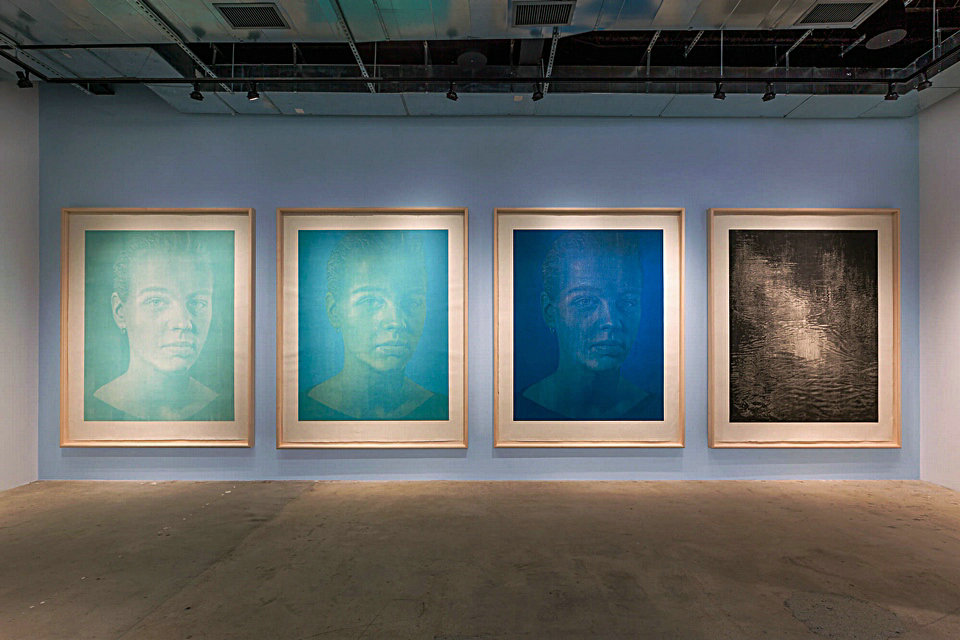Franz Gertsch: Polyfocal Allover, Swiss Institute / Contemporary Art New York


Polyfocal Allover is the first institutional painting survey of Swiss artist Franz Gertsch (b. 1930, Mörigen) in the United States. The exhibition explores Gertsch’s decades-long commitment to capturing life in portraiture, primarily through photorealist paintings and woodcut prints.
For the first time in decades, several major works from the artist’s monumental series of ‘situation portraits’ from the 1970s will be reunited, including At Luciano’s House (1973), Luciano I (1976), Luciano II (1976), and Portrait of Urs Luthi (1970). Based on photographs Gertsch took of a group of young friends who had begun living in a commune in Lucerne after 1968, including celebrated artists Luciano Castelli and Urs Luthi, the paintings capture the subjects’ lively presence as social beings in formation, surrounded by a clutter of clothes, makeup and unwashed dinner plates. The extraordinarily rendered details illuminated by the stark light of a camera flash capture an interest in American counterculture, as well as a playfulness with codes of sexuality and gender.
The exhibition will also feature a suite of Gertsch’s large woodcut prints, a medium which the artist devoted himself to exclusively between 1986 and 1995. Several prints from the series Natascha IV (1988) are based on the same image of a young woman, with a glacial, yet luminous expression. These are accompanied by Schwarzwasser (1991), a study of subtle movement on the surface of a body of water. For the first time, the limewood printing blocks used to print Natascha IV will also be exhibited, revealing the tiny raster-like gouges that Gertsch makes to register points of light.
Gertsch’s longstanding artistic interest in the mirror as a surface on which a myriad of such identities might be perceived is captured in a small collection of early works. In a number of early paintings, drawings and woodcut prints, including Spiegel (1961), and Mädchen vor dem Spiegel (1960), individuals are seen reflected in looking glasses and contemplating their reflections, pointing to a lifelong interest in capturing the nuances of the self.
About Franz Gertsch
Franz Gertsch was born in 1930 in Mörigen, Bern, and lives and works in Rüschegg-Heubach, Switzerland. Gertsch has participated in several important international exhibitions over his career, perhaps most significantly in Documenta 5 (1972) in a section organized by Harald Szeemann, Jean-Christophe Ammann and others, that looked to artists they saw to be ‘interrogating reality’. Other group exhibitions include the Venice Biennale in 1978 and 1999. Solo exhibitions include: Kunthalle Basel (1975); Kunsthalle Düsseldorf, Germany (1975); Sprengelmusuem Hannover, Germany (1980); Kunsthaus Zürich, Switzerland (1980); Museum of Modern Art, New York (1990); Hirschhorn Museum and Sculpture Garden, Washington (1991); Kunstmuseum Bern, Switzerland (1994); Albertina Museum, Vienna (2006); Mumok, Vienna (2006); Saarlandmuseum, Saarbrüken, Germany; and Musée Jenisch, Vevey, Switzerland (2017). Gertsch has been the recipient of muliple grants and prizes, including the DAAD Grant, Berlin (1974-75) and the Prinze oft he Bürgi-Willert-Stiftung. There is a museum devoted to the work of Gertsch, Museum Franz Gertsch, in Burgdorf, Switzerland.
Franz Gertsch: Polyfocal Allover is made possible through the support of the Franz Gertsch Exhibition Circle, the Robert Lehman Foundation and Ben Frija. Swiss Institute extends its deepest gratitude to the lenders to the exhibition: Art Collection EFG Private Banking, Zurich; Graphische Sammlung ETH Zürich; The Sander Collection; and a number of private collections.
Swiss Institute / Contemporary Art New York, United States
Founded in 1986, Swiss Institute (SI) is one of New York’s key non-profit institutions for contemporary art. Open to the public free of charge, it provides a significant forum for contemporary cultural dialogue between Europe and the United States. Swiss Institute produces four exhibitions per year along with a series of public programs including lectures, performances, and screenings. Recent highlights include solo or duo exhibitions of emerging artists including Allyson Vieira, Pamela Rosenkranz, Nikolas Gambaroff, and Nicolas Party; shows presenting specific bodies of work by celebrated artists such as John Armleder and Roman Signer; as well as rediscoveries of overlooked figures including Karlheinz Weinberger and Heidi Bucher. Swiss Institute’s artistic program is supported by institutional and corporate sponsors as well as the generosity of individuals.
The Swiss Institute / Contemporary Art New York (SI) is an independent non-profit contemporary art organization temporarily located at 102 Franklin Street in Tribeca, Manhattan. The organization’s goal is to explore how a national perspective can foster international conversations. Exhibitions include visual and performing arts, design and architecture, and admission is free.
The Institute occupied the third floor loft of the New Era Building from 1994 until 2011. The one-room space was used as a gallery featuring primarily Swiss and other European contemporary artists with a goal of promoting “cultural dialogue” among Switzerland, Europe, and the United States, and interaction among the Swiss community and other communities in New York. The space, constructed to museum-quality standards by the firm Pagnamenta & Torriani, was also frequently used for concerts, talks and other events.
In Summer 2017, Swiss Institute will move to a former bank at 38 St. Marks Place at Second Avenue. The 7,500 square foot space, designed by Selldorf Architects, is on four levels: basement, ground, second floor, and roof. The design for the building will include spaces for exhibitions, projects and public programs, a library, a bookstore, and a usable rooftop.